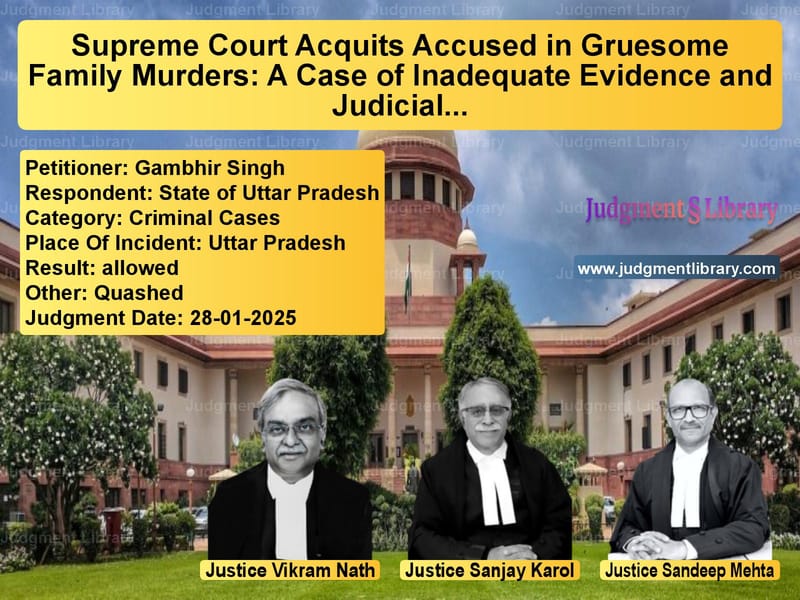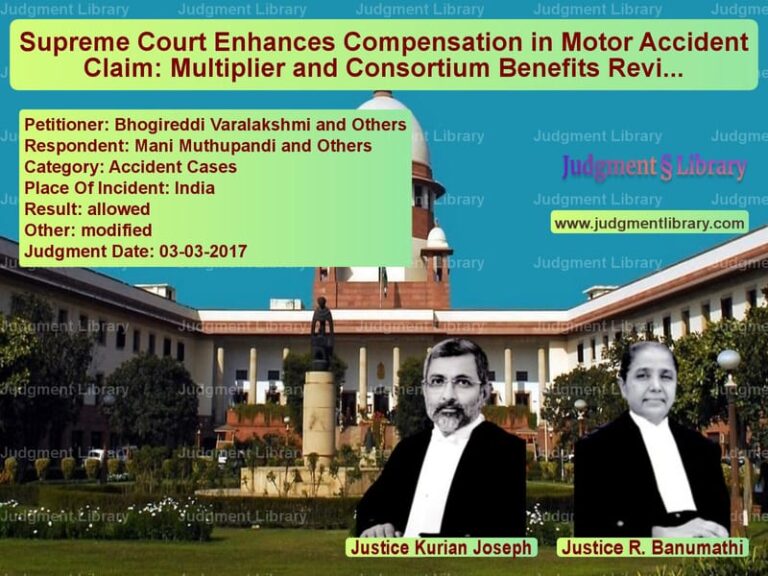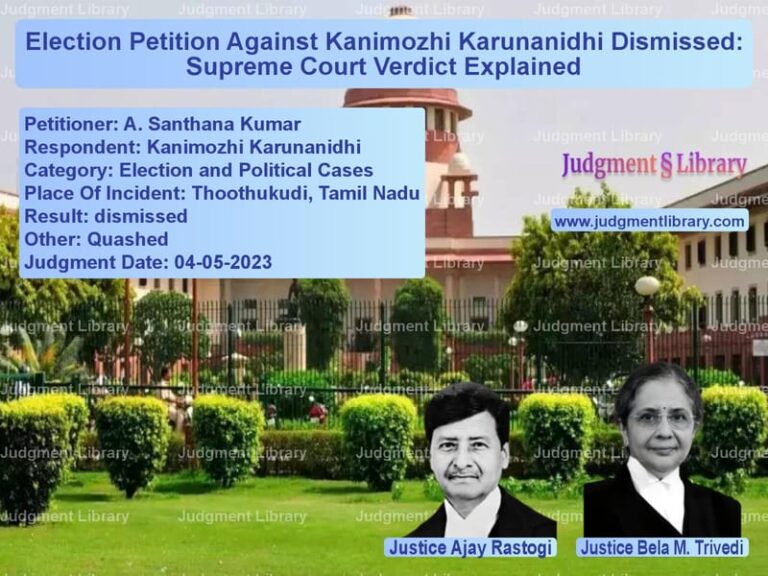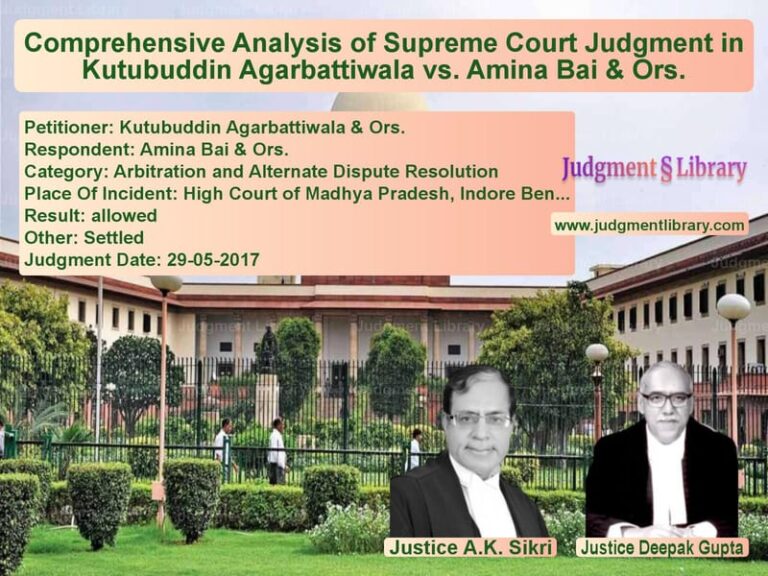Supreme Court Acquits Accused in Gruesome Family Murders: A Case of Inadequate Evidence and Judicial Scrutiny
The Supreme Court of India, in the case of Gambhir Singh v. State of Uttar Pradesh, delivered a critical judgment in which it acquitted the appellant, Gambhir Singh, who had been sentenced to death by the trial court and whose conviction was upheld by the High Court. The case revolved around the murder of six family members, including four innocent children, in the village of Turkiya. The judgment is significant not only for its outcome but also for the Court’s scrutiny of circumstantial evidence, particularly when the prosecution relies on the theories of ‘last seen’, ‘motive’, and ‘recovery of weapons’.
In the aftermath of the brutal killings, the appellant was arrested based on circumstantial evidence, including claims that he had a motive due to land disputes with his deceased brother. However, the Supreme Court found that the prosecution’s case lacked sufficient evidence to establish the guilt of the appellant beyond a reasonable doubt. The Court’s decision highlights the critical importance of reliable and corroborative evidence in securing convictions for serious offenses such as murder.
Background of the Case
The gruesome murders took place in the early hours of May 9, 2012, in the house of the deceased victims in Turkiya village. The victims, including the appellant’s brother, sister-in-law, and their four children, were brutally hacked to death with sharp-edged weapons. The informant, Mahaveer Singh, the brother of the deceased sister-in-law, reached the crime scene and reported the incident to the police.
The police investigation revealed that the appellant, Gambhir Singh, had a longstanding land dispute with his brother, Satyabhan, and the two had been involved in a previous legal case concerning the sale of a piece of land. This dispute was suggested to be the motive for the killings. The prosecution relied on the theories of motive, last seen, and recovery of blood-stained weapons to establish the appellant’s involvement in the murders.
However, the appellant denied the charges and argued that the evidence presented by the prosecution was based on hearsay and lacked credibility. Despite this, the trial court convicted him, and the High Court affirmed the conviction and the death sentence. Gambhir Singh then appealed to the Supreme Court, seeking to overturn the conviction on the grounds of insufficient evidence and procedural flaws in the investigation.
Key Legal Issues
- Whether the circumstantial evidence presented by the prosecution was sufficient to establish the appellant’s guilt beyond a reasonable doubt.
- The applicability of the theories of ‘last seen’, ‘motive’, and ‘recovery of weapons’ in convicting the appellant, given the lack of direct evidence.
- The legal standards required to convict a person under Section 302 IPC, particularly in cases based solely on circumstantial evidence.
- The role of judicial scrutiny in cases involving serious charges, especially where the death penalty has been imposed.
Arguments of the Parties
Petitioner’s Arguments
The appellant, Gambhir Singh, was represented by his legal counsel, who made the following key arguments:
- The prosecution failed to prove the crucial circumstantial evidence beyond a reasonable doubt. The ‘last seen’ theory was not supported by concrete evidence, and there were discrepancies in the testimonies of the witnesses.
- There was no clear motive established for the murders. The argument that a land dispute led to the brutal killings was based on assumptions rather than verified facts.
- The recovery of the murder weapons, such as the axe (kulhari) and dagger (katari), was not conducted properly, and the prosecution failed to establish a direct link between the appellant and the weapons.
- Crucial evidence, such as the sale of land and the personal enmity between the appellant and the deceased, was either not proved or not relevant to the commission of the murders.
Respondent’s Arguments
The State, represented by the prosecution, argued the following points:
- The prosecution had established a clear motive for the murders based on the ongoing land dispute between the appellant and his brother, Satyabhan. The appellant had a strong financial incentive to eliminate his brother and his family.
- The theory of ‘last seen’ was corroborated by the testimonies of witnesses, who stated that the appellant was seen in the vicinity of the crime scene shortly before the murders took place.
- The recovery of blood-stained weapons from the appellant’s possession, along with the appellant’s admission during the investigation, pointed to his involvement in the murders.
- The prosecution also relied on the fact that the appellant had been arrested near the scene of the crime, which suggested that he was directly involved in the killings.
Supreme Court’s Observations
The Supreme Court, after considering the arguments from both sides, made the following key observations:
“Circumstantial evidence, while powerful, must form a complete chain of events that conclusively point to the guilt of the accused. The law is well-settled that the chain of circumstances must be unbroken and should exclude every possible hypothesis other than the guilt of the accused.”
The Court further emphasized the importance of corroboration in circumstantial evidence, stating that no single piece of evidence, such as the ‘last seen’ theory or the motive, could be relied upon in isolation. The Court also noted that the prosecution had failed to establish the full chain of events leading to the murder, particularly in relation to the recovery of weapons and the failure to prove the motive beyond speculation.
The Court was critical of the prosecution’s reliance on hearsay evidence and weak testimonies from the witnesses. The appellant’s counsel had pointed out that key witnesses had either retracted their statements or failed to provide clear evidence of the appellant’s involvement in the crime.
Final Judgment and Directions
The Supreme Court, after evaluating the facts, evidence, and legal arguments, ruled as follows:
- The conviction of Gambhir Singh under Section 302 IPC was overturned. The Court found that the prosecution had failed to establish the guilt of the appellant beyond a reasonable doubt.
- The death sentence imposed on the appellant was set aside. The Court noted that while the crime was heinous, the lack of conclusive evidence and the flaws in the prosecution’s case warranted the quashing of the conviction and sentence.
- The appellant was acquitted of all charges, and the order of his release from prison was issued.
- The Supreme Court also directed a review of procedural safeguards in cases where circumstantial evidence plays a pivotal role in securing convictions, especially in cases involving serious charges like murder.
Implications of the Judgment
This ruling sets a significant precedent in the law regarding the use of circumstantial evidence in murder cases. The Court reaffirmed that while circumstantial evidence can be compelling, it must form a complete and unbroken chain that conclusively points to the accused’s guilt. The judgment also emphasizes the need for the prosecution to provide clear, corroborated evidence and for courts to be cautious in relying on speculative theories without solid proof.
Conclusion
The Supreme Court’s decision in Gambhir Singh v. State of Uttar Pradesh is a crucial judgment for criminal law, particularly in cases based on circumstantial evidence. The case highlights the importance of due process and the need for conclusive evidence in securing convictions. It serves as a reminder that the principles of fairness, justice, and beyond-reasonable-doubt proof must guide the judicial process, especially in the most serious cases involving life and death sentences.
Petitioner Name: Gambhir Singh.Respondent Name: State of Uttar Pradesh.Judgment By: Justice Vikram Nath, Justice Sanjay Karol, Justice Sandeep Mehta.Place Of Incident: Uttar Pradesh.Judgment Date: 28-01-2025.
Don’t miss out on the full details! Download the complete judgment in PDF format below and gain valuable insights instantly!
Download Judgment: gambhir-singh-vs-state-of-uttar-prade-supreme-court-of-india-judgment-dated-28-01-2025.pdf
Directly Download Judgment: Directly download this Judgment
See all petitions in Murder Cases
See all petitions in Bail and Anticipatory Bail
See all petitions in Suicide Cases
See all petitions in Judgment by Vikram Nath
See all petitions in Judgment by Sanjay Karol
See all petitions in Judgment by Sandeep Mehta
See all petitions in allowed
See all petitions in Quashed
See all petitions in supreme court of India judgments January 2025
See all petitions in 2025 judgments
See all posts in Criminal Cases Category
See all allowed petitions in Criminal Cases Category
See all Dismissed petitions in Criminal Cases Category
See all partially allowed petitions in Criminal Cases Category







